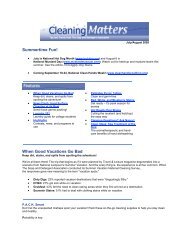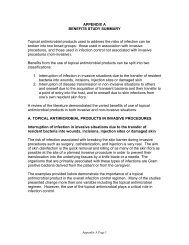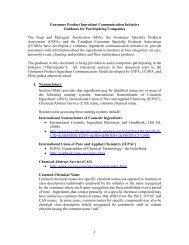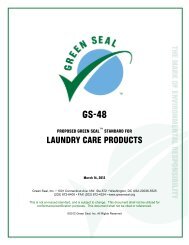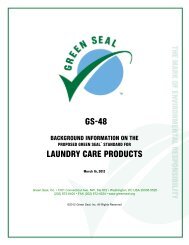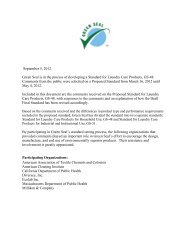subchapter c -- federal hazardous substances act regulations
subchapter c -- federal hazardous substances act regulations
subchapter c -- federal hazardous substances act regulations
You also want an ePaper? Increase the reach of your titles
YUMPU automatically turns print PDFs into web optimized ePapers that Google loves.
involved presents an imminent hazard to the<br />
public health, the Commission may by order<br />
published in the FEDERAL REGISTER give<br />
notice of such finding, and thereupon such<br />
substance when intended or offered for<br />
household use, or when so packaged as to be<br />
suitable for such use, shall be deemed to be a<br />
”banned <strong>hazardous</strong> substance” pending the<br />
completion of proceedings relating to the<br />
issuance of such <strong>regulations</strong>.<br />
(16) ”Electrical hazard”-- an article may<br />
be determined to present an electrical hazard<br />
if, in normal use or when subjected to<br />
reasonably foreseeable damage or abuse, its<br />
design or manuf<strong>act</strong>ure may cause personal<br />
injury or illness by electric shock.<br />
(17) ”Mechanical hazard”-- an article<br />
may be determined to present a mechanical<br />
hazard if, in normal use or when subjected to<br />
reasonably foreseeable damage or abuse, its<br />
design or manuf<strong>act</strong>ure presents an<br />
unreasonable risk of personal injury or illness:<br />
(i) From fr<strong>act</strong>ure, fragmentation, or<br />
disassembly of the article;<br />
(ii) From propulsion of the article (or any<br />
part or accessory thereof);<br />
(iii) From points or other protrusions,<br />
surfaces, edges, openings, or closures;<br />
(iv) From moving parts;<br />
(v) From lack or insufficiency of controls<br />
to reduce or stop motion;<br />
(vi) As a result of self-adhering<br />
char<strong>act</strong>eristics of the article;<br />
(vii) Because the article (or any part or<br />
accessory thereof) may be aspirated or<br />
ingested;<br />
(viii) Because of instability; or<br />
(ix) Because of any other aspect of the<br />
article's design or manuf<strong>act</strong>ure.<br />
(18) ”Thermal hazard” -- an article may<br />
be determined to present a thermal hazard if,<br />
in normal use or when subjected to reasonably<br />
foreseeable damage or abuse, its design or<br />
manuf<strong>act</strong>ure presents an unreasonable risk of<br />
personal injury or illness because of heat as<br />
from heated parts, <strong>substances</strong>, or surfaces.<br />
(c) Certain statutory definitions<br />
interpreted, supplemented, or provided with<br />
alternatives. The following items interpret,<br />
supplement, or provide alternatives to<br />
definitions set forth in section 2 of the <strong>act</strong> (and<br />
restated in paragraph (b) of this section):<br />
(1) The following is an alternative to the<br />
definition of ”highly toxic” in section 2(h) of<br />
16 CFR Ch. II (1–1–05 Edition)—proposed modificication – 6/25/06<br />
-- 5 --<br />
the <strong>act</strong> (and paragraph (b)(6) of this section);<br />
Highly toxic means a substance that meets the<br />
definition of “toxic” in one of the following<br />
categories, based on the route of exposure, as<br />
specified in paragraph (c)(2)(i) of this section:<br />
(i) Administered orally: Category 1 or<br />
Category 2;<br />
(ii) Administered via inhalation (gas):<br />
Category 1;<br />
(iii) Administered via inhalation (vapor):<br />
Category 1;<br />
(iv) Administered via inhalation (dust/mist):<br />
Category 1, Category 2 or Category 3;<br />
(v) Administered dermally: Category 1 or<br />
Category 2.<br />
(2) To give specificity to the definition of<br />
”toxic” in section 2(g) of the <strong>act</strong> (and restated<br />
in paragraph (b)(5) of this section), the<br />
following supplements that definition.<br />
(i) Acute toxicity. Toxic, as specified in the<br />
following categories, means any substance that<br />
produces death within 14 days in half or more<br />
than half of a group of:<br />
(A) White rats (each weighing between 200<br />
and 300 grams) when a single dose is<br />
administered orally at the following levels:<br />
Category 1 – less than or equal to 5 milligrams<br />
per kilogram of body weight;<br />
Category 2 – greater than 5 but less than or<br />
equal to 50 milligrams per kilogram of body<br />
weight;<br />
Category 3 – greater than 50 but less than or<br />
equal to 300 milligrams per kilogram of body<br />
weight;<br />
Category 4 – greater than 300 but less than or<br />
equal to 2000 milligrams per kilogram of body<br />
weight;<br />
Category 5 – greater than 2000 but less than or<br />
equal to 5000 milligrams per kilogram of body<br />
weight.<br />
Substances falling in the toxicity range<br />
between 500 milligrams and 5000 milligrams<br />
per kilogram of body weight will be<br />
considered for exemption from some or all of<br />
the labeling requirements of the <strong>act</strong>, under §<br />
1500.82, upon a showing that such labeling is<br />
not needed because of the physical form of the<br />
<strong>substances</strong> (solid, a thick plastic, emulsion,<br />
etc.), the size or closure of the container,<br />
human experience with the article, or any other<br />
relevant f<strong>act</strong>ors;<br />
(B) White rats (each weighing between 200<br />
and 300 grams) when an atmospheric<br />
Deleted: A substance determined by the<br />
Commission to be highly toxic on the<br />
basis of human experience; and/or<br />
Deleted: A substance that produces<br />
death within 14 days in half or more than<br />
half of a group of:<br />
(A) White rats (each weighing<br />
between 200 and 300 grams) when a<br />
single dose of 50 milligrams or less per<br />
kilogram of body weight is administered<br />
orally;<br />
(B) White rats (each weighing<br />
between 200 and 300 grams) when a<br />
concentration of 200 parts per million by<br />
volume or less of gas or vapor, or 2<br />
milligrams per liter by volume or less of<br />
mist or dust, is inhaled continuously for 1<br />
hour or less, if such concentration is<br />
likely to be encountered by man when the<br />
substance is used in any reasonably<br />
foreseeable manner; and/or<br />
(C) Rabbits (each weighing between<br />
2.3 and 3.0 kilograms) when a dosage of<br />
200 milligrams or less per kilogram of<br />
body weight is administered by<br />
continuous cont<strong>act</strong> with the bare skin for<br />
24<br />
hours or less by the method described in §<br />
1500.40. The number of animals tested<br />
shall be sufficient to give a statistically<br />
significant result and shall be in<br />
conformity with good pharmacological<br />
pr<strong>act</strong>ices.<br />
Deleted: The following categories are<br />
not intended to be inclusive.<br />
Deleted: of<br />
Deleted: from 50 milligrams to 5 grams<br />
Deleted: is administered orally<br />
Deleted: 5 grams<br />
Deleted: o provide flexibility as to the<br />
number of animals tested, t



